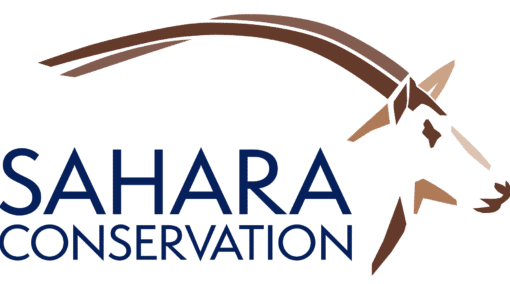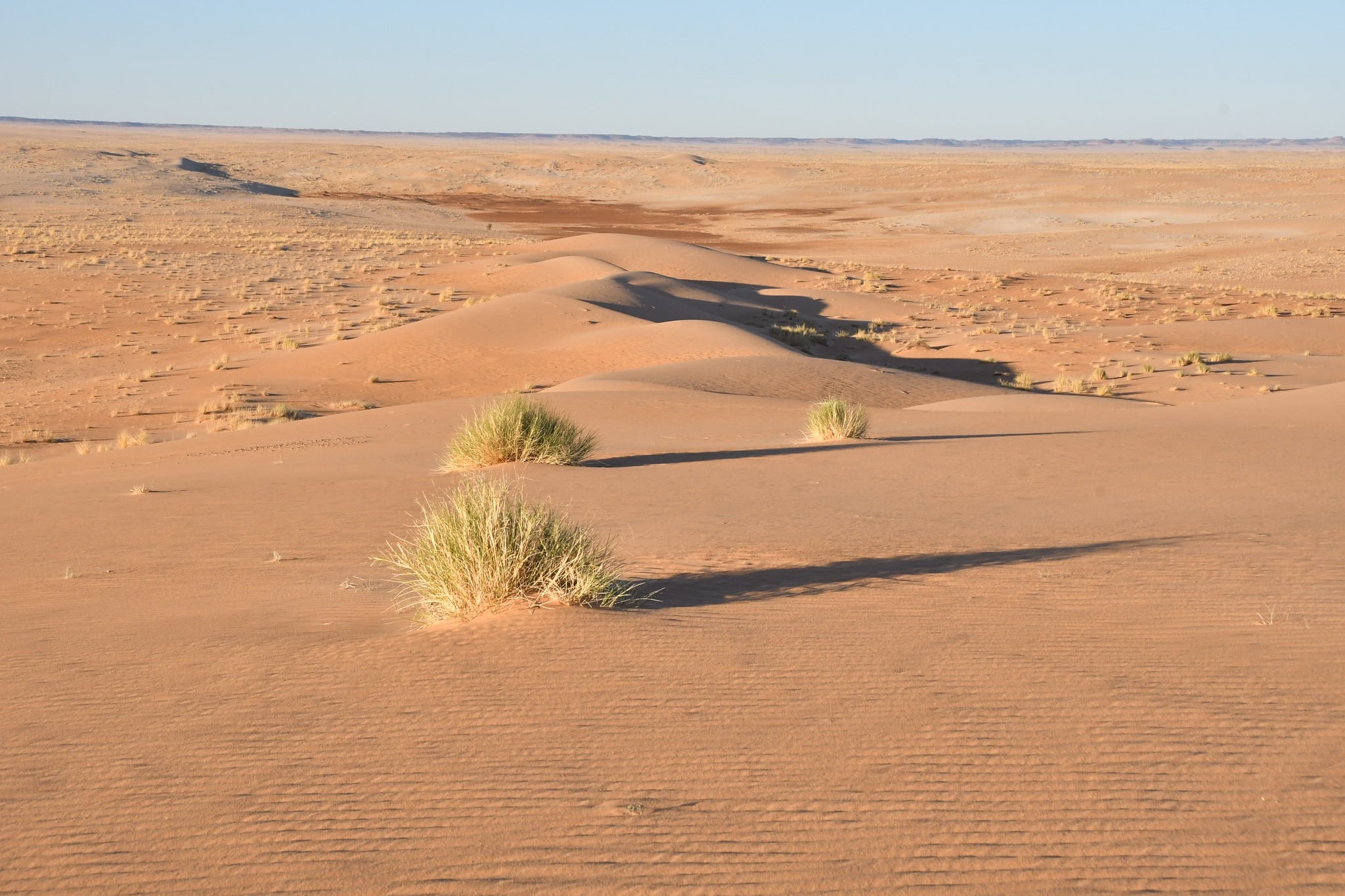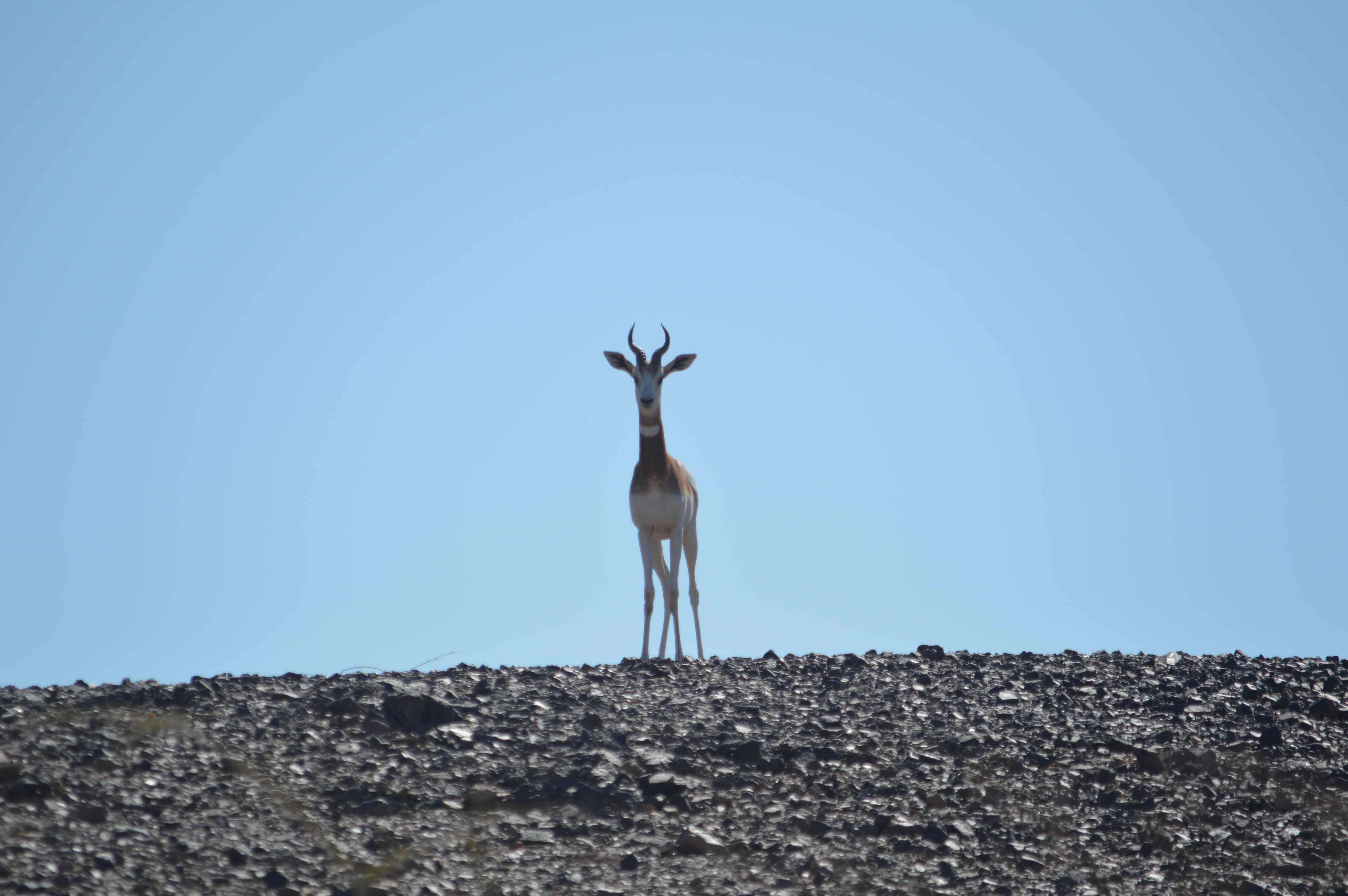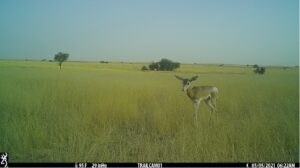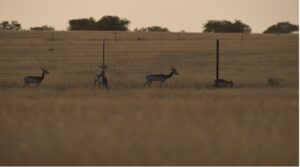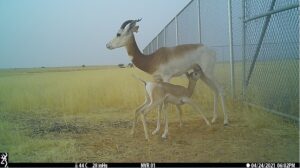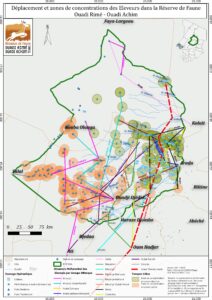Sahara Conservation is a pioneering international conservation organisation working at the forefront of efforts to save the threatened wildlife of the Sahara and Sahel. Since its inception in 2004, Sahara Conservation has helped protect and restore unique desert antelopes such as the addax and scimitar-horned oryx, established one of the world’s largest protected areas in Niger, implemented a recovery program for the world’s largest bird, the North African ostrich, and put Saharan wildlife on the global conservation agenda through a combination of fieldwork, communication, and advocacy. read more
Author Archive
Once widespread in the Sahelo-Saharan region of Africa, the dama gazelle (Nanger dama) is now one of the continent’s most threatened antelope, classified as Critically Endangered by the UICN Red List, with less than 200 animals surviving in the wild. read more
In January 2020, a helicopter capture operation was conducted to translocate gazelles from the Manga region to the Ouadi Rimé-Ouadi Achim protected area in central Chad. By bringing back one male among the three captured gazelles, the rescue mission was a success, as a breeding group was created. With the birth of a second dama gazelle, we can hope that the group will progressively grow.
The joint efforts of the various stakeholders were rewarded with the birth of a second baby gazelle, a female. With so few individuals left in their original range, each birth is of vital importance and gives hope in the fight for the conservation of the species.
Since her birth, the little female is in good condition despite the very hot weather. The SCF teams are proud of this birth, proof that the work done is bearing fruit.
This was a key operation of the 2019-2028 dama gazelles conservation strategy. In order to prevent the extinction of these gazelles, the Chadian government along with the Sahara Conservation Fund (SCF), the IUCN/SSC Antelope Specialist Group, the Segré Foundation, Rewild, and the Royal Zoological Society of Scotland, have partnered to carry out this operation. The current population numbers less than 100 individuals in the wild, indicating an unprecedented urgency for the preservation and transmission of the wild genes of these animals.
Experts are studying the possibility of translocating dama gazelles from zoos and other parts of the world to expand the group. In collaboration with the SCF team, they are working on the best way to prolong the benefit of this rescue operation, so that the group can flourish and strengthen the existing population.
Dans le cadre du projet d’appui à l’aménagement de la Réserve de Faune de Ouadi Rimé-Ouadi Achim co-financé par l’Union européenne, le Sahara Conservation Fund, en collaboration avec la Direction de la Conservation de la Faune et des Aires Protégées, développe un plan d’aménagement afin d’aider à la gestion durable de sa biodiversité. En octobre 2020, des missions de collectes de données et d’informations sur différentes thématiques accès sur les activités humaines ont eu lieu. Des informations et données nécessaires permettant d’équilibrer la quantité d’informations disponibles sur la connaissance de la faune dans la réserve. Etant une action concertée d’organisation, de planification et de gestion d’un espace et de ses ressources, le plan d’aménagement implique la participation des acteurs locaux.
L’information joue un rôle important dans l’élaboration et la mise en œuvre d’un tel outil de gestion. La présentation d’une information, précise et utile peut trancher entre un résultat souhaitable et un résultat médiocre, voire préjudiciable. Ainsi la cartographie est de plus en plus utilisée dans la prise de décisions, notamment en matière de planification et de gestion des ressources naturelles.
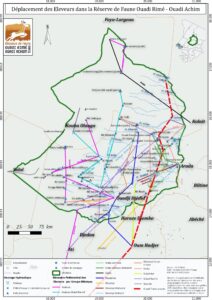
Visualisation spatiale de la répartition des ressources naturelles et des activités humaines
Les cartes représentent un outil adéquat de présentation de l’information, mais aussi une base permettant l’expression des idées et la représentation des connaissances ‘’théoriques’’. Nous appelons cela « la cartographie à vue d’acteur ou carte participative ». Dans le processus d’élaboration du plan de gestion, nous réunissons quelquefois les acteurs locaux et leur demandant de placer selon leurs connaissances théoriques du milieu, les différentes infrastructures existantes et zones d’activités humaines. Cette carte dessinée à la main sert ensuite de support dans les différentes séquences de collecte de données thématiques. Cette méthode a servi notamment à définir après géo-référencement, le réseau d’itinéraires de transhumance qui traverse la réserve, les points d’eau, les zones de concentrations des éleveurs en différentes saisons… Ces informations représentées sur une carte et croisées avec les données de répartition de la faune, contribuent à améliorer la transparence du processus décisionnel public (le débat du zonage).
C’est-à-dire que la représentation cartographique complète (réunissant toutes les thématiques), nous a permis d’établir et d’appliquer les critères objectifs de sélection ou de catégorisation pour les différents scénarios de zonages, ce qui contribuera donc à améliorer la transparence et la participation de tous les acteurs.
La lecture et l’analyse visuelle des informations représentées sur ces cartes permet donc de planifier et d’orienter les actions en matière de gestion.
Il convient de dire que la représentation d’informations plus précises sur la superficie, les limites, les ressources naturelles et les infrastructures existantes, fournit une base plus équitable pour la discussion et la prise de décision objectif.
N’Djaména, Chad Monday 30th August 2021
Today, the Ministry of Environment, Fisheries, and Sustainable Development and the Sahara Conservation Fund (SCF) signed a US$5 million agreement to implement the ALBIÄ project: a word that appropriately means “environment” in local Arabic.
The ALBIÄ project will improve natural resource management and the livelihoods of the populations in climate-vulnerable areas in the vast 75,950 km2 Ouadi Rimé-Ouadi Achim Game Reserve (OROAGR) in the central-north region of the Chadian Sahelo-Saharan zone. This award comprises part of the $54.5 million dollars awarded by the World Bank’s Board of Board of Executive Directors approved in June 2020. ALBIÄ is funded from International Development Association (IDA)* and the Global Environment Facility (GEF)**.
Over the next four and a half years, under a co-management agreement with the provincial and national authorities, SCF will improve the Reserve management, improve infrastructure through the construction offices for the government protected area administration, improve roads and communication across the remote reserve, seek to improve the control of fires, and support community participation in sustainable natural resources management. This project works in tandem with the livelihoods and climate adaptation project that will be implemented in the five Provinces surrounding the Reserve that is implemented by SOS Sahel.
John Watkin, CEO of SCF, said, “Managing an area the size of Scotland in central Chad requires significant financial resources. ALBIÄ is a vital compliment and expansion of the European Union funded Projet Ouadi Rimé-Ouadi Achim to ensure that the Reserve is managed effectively for the benefit of local people and wildlife including the reintroduced scimitar-horned oryx, addax and North African ostrich”. Adding, “I would like to thank the honorable Minister Mr. Mahamat Ahmat Lazina for his considerable efforts in achieving this milestone to improve Chad’s natural resource management in the face of severe climate change impacts.”
Since 2016, in conjunction with the Environment Agency Abu Dhabi (EAD), SCF has initiated a program of reintroducing the once extinct scimitar-horned oryx, reinforcing the population of addax through to number less than 100 individual remaining in the wild. Over the last six years 218 oryx have been returned to the wild where they have thrived and now number at least 350 free-living individuals. Similarly, since November 2019, 49-addax have been released reinforcing the tiny population less than 100 individuals in the region. The addax has also adapted admirably to their new home with several new calves being recorded.
*The International Development Association (IDA) is the World Bank’s fund for the poorest. Established in 1960, it provides grants and low to zero-interest loans for projects and programs that boost economic growth, reduce poverty, and improve poor people’s lives. IDA is one of the largest sources of assistance for the world’s 76 poorest countries, 39 of which are in Africa. IDA resources help effect positive change in the lives of the 1.6 billion people living in the countries that are eligible for its assistance. Since 1960, IDA has supported development work in 113 countries. Annual commitments have averaged $21 billion over the past three years, with about 61% going to Africa.
**The Global Environment Facility (GEF) is an international financial mechanism with 176 member countries that addresses global environmental issues while supporting national sustainable development initiatives. The GEF’s grants support projects in developing countries related to biodiversity, climate change, international water, land degradation, the ozone layer, and persistent organic pollutants. The GEF has been a driving force since its inception in 1991 to improve the lives of millions of people while creating the conditions for sustainable development. Its project portfolio is diverse, and, as with any investment portfolio, provides returns that vary over several time horizons. The GEF is a social entrepreneur, providing, for example, more than 10,000 small grants directly to community groups and other civil society organizations in 120 countries.
